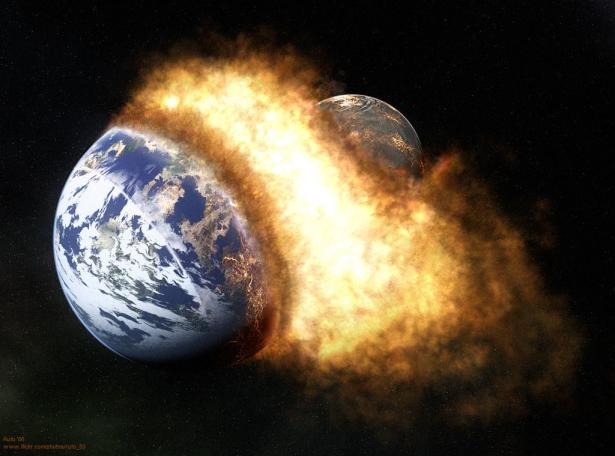Where did the moon come from? The most popular theory says that about 4.5 billion years ago, a Mars-size protoplanet slammed into Earth. Some of the resulting debris, tossed into orbit, coalesced to form the moon.
This idea, known as the “big whack,” would explain much about the moon. But scientists have lacked smoking-gun evidence like a crater or pieces of the protoplanet, named Theia.
In a study published on Wednesday in the journal Nature, researchers assert that pieces of Theia did survive the impact — but way down, sitting on the boundary between Earth’s mantle and core, 1,800 miles below the surface.
“We looked into the deeper Earth,” said Qian Yuan, a postdoctoral researcher at the California Institute of Technology who led the research. “We found big chunks of the impactor Theia.”
Dr. Yuan’s interest started during a planetary geochemistry class while he was a graduate student at Arizona State University. He recalled that the professor asked a straightforward question: “Where is the impactor Theia right now?”
“It really sparked me to have this idea,” Dr. Yuan said.
Some of Theia now makes up the moon. But if Theia was the size of Mars, then about 90 percent of its mass ended up back on Earth. Some of that certainly melted and mixed into Earth’s minerals. But perhaps some pieces of the protoplanet persisted almost intact.
Dr. Yuan wondered if these pieces might be what makes up two mysterious structures deep inside the Earth, at the boundary between the core and the mantle. The blobs — one under West Africa, the other under the Pacific Ocean — span an area as large as a continent, and stretch upward hundreds of miles into the mantle.
They were first spotted a half-century ago, when researchers realized that seismic waves — the shaking generated by earthquakes — slowed down when passing through these regions. It is difficult to discern much about the structures other than that they exist. The seismic data are like a sonogram of the planet, offering fuzzy, impressionistic views of the structure. They do not tell the temperature or what the structures are made of. It is impossible to drill that far into the planet to pull up samples.
The blob under West Africa is known as Tuzo, after J. Tuzo Wilson, a Canadian geophysicist and pioneer in the theory of plate tectonics. The other, deep under the Pacific Ocean, is called Jason, after W. Jason Morgan, who suggested that the hot spots originated from plumes of material rising from the deep mantle.
Some scientists have proposed that perhaps Tuzo and Jason were made of primordial Earth — crystallized parts of the magma ocean that once covered the surface that never mixed with the rest of the mantle. Others thought the structures could be chunks of ocean crust that sank into the mantle.
Dr. Yuan noted the volume of Tuzo and Jason were roughly comparable to that of the moon, leading him and his colleagues to wonder if they might be additional pieces of Theia.
In the Nature paper, they carried out a series of computer simulations, breaking down Theia and Earth into pieces and tracking the movement of the pieces during and after the collision.
When Theia hit Earth, the models found, the collision melted the crust and outer part of the mantle of Earth, mixing them with bits of Theia. The moon formed out of that cloud of debris.
The simulations also showed that more than 10 percent of Theia’s mantle could have ended up embedded in the Earth’s deep mantle, Dr. Yuan said. Because Theia’s mantle is believed to have been richer in iron than Earth’s, those denser bits could have sunk to Earth’s core-mantle boundary. Convection in the mantle then swept up the Theia bits into Tuzo and Jason. (In the simulations, either two or three structures formed.)
“To me, it’s very interesting and novel,” said Paul Tackley, a professor of geophysics at the Swiss Federal Institute of Technology in Zurich who was not involved in the new study.
Dr. Tackley said the simulations provided a compelling hypothesis, but not proof, and Dr. Yuan said it was still possible that the blobs came from ocean crust or primordial remnants.
“Our study cannot exclude other reasons,” Dr. Yuan said.
The findings might spur scientists to look more closely at how the giant impact may have influenced the conveyor-belt movement of the continents. “It may have had long-lasting effects on Earth’s subsequent evolution,” Dr. Yuan said.
Kenneth Chang has been at The Times since 2000, writing about physics, geology, chemistry, and the planets. Before becoming a science writer, he was a graduate student whose research involved the control of chaos. More about Kenneth Chang
Get the best of The Times in your inbox from a free newsletter.


Spread the word